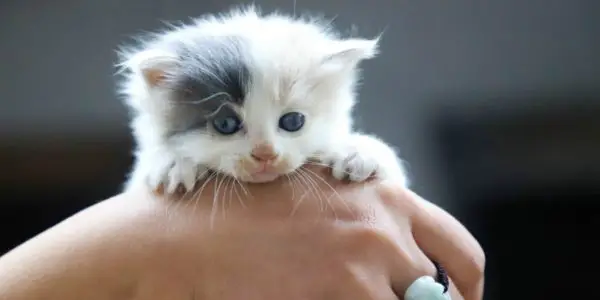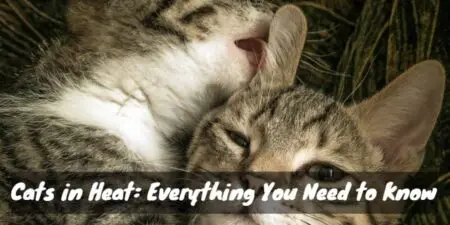The answer is surprisingly complicated, for it can depend on the breed. While most cats reach puberty when they are around 6 or 7 months old, some can reach puberty when they are as young as 4 months or as old as 10 months.
Even defining what a kitten is can be surprisingly tricky. Most people, including cat food manufacturers, define a kitten as a juvenile cat under a year old. Veterinarians, however, tend to use the following “life stage” chart:

- Birth to six months – Kitten
- Seven to 24 months – Junior
- Three to six years – Prime
- Seven to ten years – Mature
- Eleven to fourteen years – Senior
- Fifteen and above – Geriatric
As cats usually reach puberty when they are around six months old, veterinarians tend to define a kitten as a young cat that hasn’t reached puberty yet. Junior cats are the feline version of teenagers. They are still growing and still full of beans. Prime and mature cats are, respectively, young adults and middle-aged adults. The senior and geriatric categories describe older cats.
Cats generally have a life expectancy of 15 years, but that life expectancy can vary depending on the breed. Some breeds, like the American Shorthair, can live as long as 20 years.
How Fast Do Kittens Grow?

A newborn kitten generally weighs only a few ounces. If properly fed, she can gain anywhere from ¼ ounce to ½ ounce per day and thus double in weight by the time she’s two weeks old. A healthy kitten should generally gain about a pound per month during her first year. Most cats will have gained ½ to ¾ their adult weight by the time they are six months old. A young cat typically weighs between six and eight pounds at that age.
Breed, gender, and health will affect how large a kitten gets. For example, it’s well-known that female cats are usually smaller than males. The growth of small breeds like the Munchkin often slows down when they are between six to eight months old. For the record, a full-grown Munchkin weighs between five and nine pounds.
At the other extreme, large cats like the Maine Coon can keep growing for four or five years! The Maine Coon is the largest of the domestic cats, and a big adult male can be four feet long from nose to tail tip and weigh over 25 pounds.
[amazon bestseller=”cat food” items=”1″ template=”table”]
In some breeds, such as the Maine Coon, a kitten’s gender affects when it reaches sexual maturity. Female kittens, for example, don’t have their first heat until they weigh about 5.5 pounds and will be between four to six months old. Male kittens, by contrast, don’t start spraying or marking territory until they are ten months old.
What Happens as a Kitten Grows Up?
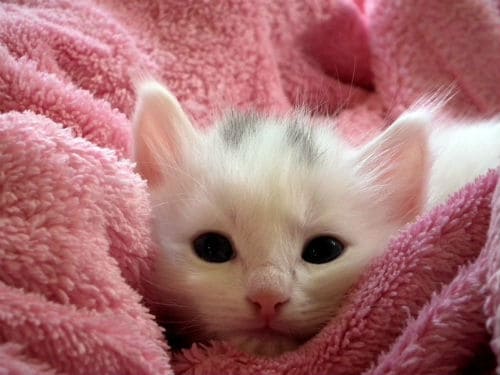
Kittens are born utterly helpless. They are blind, deaf, and can barely move. During their first two weeks of life, which is sometimes called the neonatal period, their senses start to develop. A kitten starts responding to sound, and their eyes open sometime during their second week.
When a kitten is three weeks old, they have a well-developed sense of smell and can see well enough to locate their mother. The time between the second and seventh weeks is the prime socialization time. Kittens need to be handled during this time to get them used to humans. Similarly, their owner needs to expose them to a variety of experiences so they don’t grow up into a fearful or aggressive cat.
Ideally, the kittens’ owner and other members of the household should gently handle the kittens for 15 to 40 minutes every day during their first seven weeks. Handling the kittens will encourage their brains to develop, and they will be better learners. They will also become more playful and curious.
A kitten’s baby teeth grow in when it is about a month old. By the time the kitten is five weeks old, it can run, pounce, avoid obstacles, and right itself after tripping or falling. It will start to groom itself and its littermates.
Kittens start eating solid food when they are between six and eight weeks old. Their mother will keep letting them suckle for a while, but she will eventually stop. She will also leave them for longer and longer periods.
Play among kittens serves a variety of functions. It helps them develop physically, making them more robust and agile. Playing also helps a kitten develop various social skills they need to know to interact successfully with other cats and humans.
Kittens learn other skills from their mother. They learn the bulk of these skills by the time they are twelve weeks old, which is why breeders and other authorities recommend not adopting out kittens until they are at least that age. A kitten taken from its mother too soon will miss out on certain lessons and may develop behavior problems.
A cat’s adult teeth grow in by the time it’s six months old—about the same as it reaches sexual maturity. Some veterinarians, in fact, will extract any remaining baby teeth at the same time that they spay or neuter a cat. A kitten should also have had all of its shots by this age.
When Should Someone Get a Kitten Fixed?
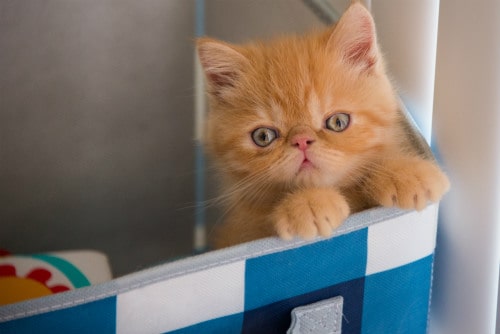
For generations, veterinarians recommended having a kitten spayed or neutered when it was six months old. Unfortunately, since some cats reach sexual maturity at four months, those cats could already have a litter of kittens before reaching their sixth month.
These days, veterinarians recommend getting cats fixed at a significantly earlier age. Some vets will spay or neuter kittens as young as six weeks old – provided they are large enough and strong enough to withstand the surgery.
The new rule is that the kitten must weigh at least two pounds before spaying or neutering. Spaying or neutering a kitten early reduces the risk of pregnancy and prevents the kitten from developing such undesirable behaviors as spraying.
How Long Does a Cat’s Gestation Last?
A cat’s gestation or pregnancy can last anywhere from 58 to 72 days, with most pregnancies lasting between 63 to 66 days.
A first-time mother will generally have two or three kittens in their litter. A cat that’s at least three years old will start having litters of around four or five kittens. An older cat’s litter will gradually decrease in size.
Some breeds, such as the Siamese, Burmese, and Oriental Shorthair, tend to have longer pregnancies and larger litters. According to the Guinness Book of World Records, the largest cat litter was born to a Siamese/Burmese mix. She had a whopping 19 kittens, four of which were stillborn.
What Is a Perma-Kitten?
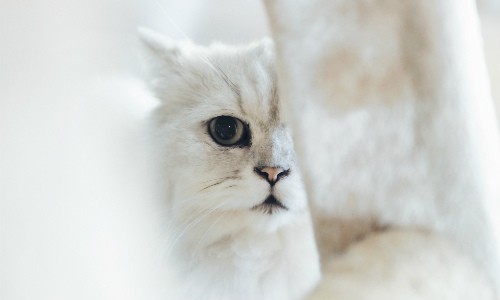
A perma-kitten is a cat that retains kitten-like traits into adulthood. The internet star, Lil Bub, is often described as a perma-kitten because she has a large head and short limbs like a kitten. Lil Bub, who was born in 2011, has a type of severe dwarfism called achondroplasia that caused her small size and disproportionate build. She also has various health problems like osteoporosis and an underdeveloped lower jaw.
Some cat breeds, such as the Munchkin or the Singapura, also seem to be permanent kittens simply because of their size. The Munchkin also has extremely short legs, making it a feline analog of a dachshund. Its head and body are normally proportioned, so it doesn’t have full-blown achondroplasia like Lil Bub. While some Munchkin cats are perfectly healthy, others have skeletal problems like osteoarthritis or an abnormal curvature of the spine called lordosis.
The Singapura is often described as the world’s smallest domestic cat. Females can weigh as little as four pounds, while a “large” male can weigh twice that. They are always a beige color called “sepia,” and they have ticked coats like that of a cougar.
A common health problem seen in Singapuras is uterine inertia. That means the muscles in the uterus are too weak to let the cat deliver its own kittens. Consequently, many Singapuras need to undergo Caesarean sections.
The Toybob is a new breed of cat that first appeared in Russia in the 1980s. It is said to be even smaller than the Singapura, and adult cats are about the size of four-month-old kittens. They can come in a variety of colors, but a majority are pointed, like the Siamese. Their fans claim they are healthy, intelligent, and playful.
What Is a Teacup Cat?
A teacup cat has been deliberately bred for its small size. It typically weighs about 2/3 of what a normal-sized member of its breed does, and some can weigh as little as five pounds. Most teacup cats are bred from Persians.
Breeding teacup cats are seemingly straightforward; the breeder mates a small male with a small female, and they produce a litter of small kittens. Unfortunately, teacup cats often have an array of health problems linked to their size. For example, they can’t regulate their body temperature as well as normal-sized cats, so they are vulnerable to temperature extremes.
Teacup cats are also more vulnerable to skeletal and joint problems like arthritis. They are also more susceptible to dental problems.
[amazon bestseller=”cats teeth care” items=”1″ template=”horizontal”]
Normal-sized Persians already have a batch of health issues caused by their extremely flat face, and such conditions are exacerbated in teacup Persians. For example, regular Persians often have breathing difficulties on account of their tiny snub nose. Since a teacup Persian’s nose is even smaller, it is even more likely to have respiratory problems like asthma.
Persians also often develop polycystic kidney disease. A teacup Persian, with its smaller kidneys, may be more vulnerable to polycystic kidney disease than a full-sized cat. Teacup Persians also have more trouble chewing food and are more vulnerable to nose and eye infections.
Kittens Time Lapse — 50 Days in 5 Minutes (Video)
"In ancient times cats were worshipped as gods; they have not forgotten this."
-- Terry Pratchett

